剑桥国际英语教程二(unit3-1)电子教案
Unit3FavoritetoysLesson1(教案)剑桥国际少儿英语第二版二年级上册
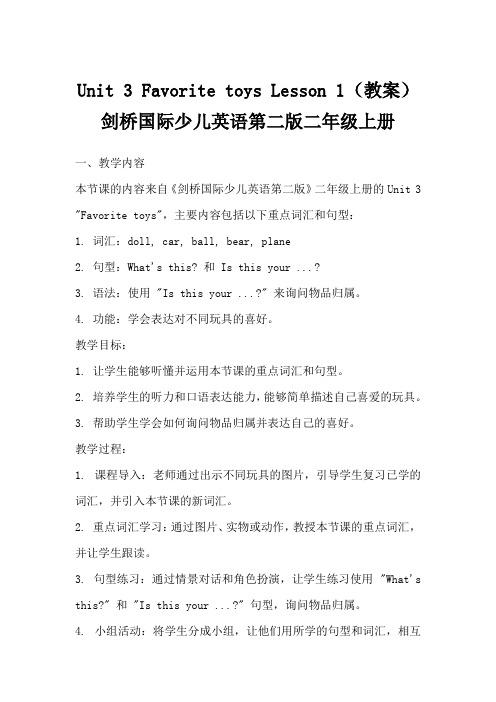
Unit 3 Favorite toys Lesson 1(教案)剑桥国际少儿英语第二版二年级上册一、教学内容本节课的内容来自《剑桥国际少儿英语第二版》二年级上册的Unit 3 "Favorite toys",主要内容包括以下重点词汇和句型:1. 词汇:doll, car, ball, bear, plane2. 句型:What's this? 和 Is this your ...?3. 语法:使用 "Is this your ...?" 来询问物品归属。
4. 功能:学会表达对不同玩具的喜好。
教学目标:1. 让学生能够听懂并运用本节课的重点词汇和句型。
2. 培养学生的听力和口语表达能力,能够简单描述自己喜爱的玩具。
3. 帮助学生学会如何询问物品归属并表达自己的喜好。
教学过程:1. 课程导入:老师通过出示不同玩具的图片,引导学生复习已学的词汇,并引入本节课的新词汇。
2. 重点词汇学习:通过图片、实物或动作,教授本节课的重点词汇,并让学生跟读。
3. 句型练习:通过情景对话和角色扮演,让学生练习使用 "What's this?" 和 "Is this your ...?" 句型,询问物品归属。
4. 小组活动:将学生分成小组,让他们用所学的句型和词汇,相互询问并表达对玩具的喜好。
5. 课堂小结:老师总结本节课所学内容,强调重点词汇和句型,并布置相关的课后作业。
二、核心素养目标本节课的核心素养目标主要包括以下几个方面:1. 语言能力:通过本节课的学习,学生能够听懂并运用本节课的重点词汇和句型,描述自己喜爱的玩具,提高学生的英语听力和口语表达能力。
2. 思维品质:通过情景对话和角色扮演,培养学生的观察力和想象力,让学生在语言实践中运用所学知识,提高学生的思维品质。
3. 文化意识:通过学习本节课的内容,让学生了解不同国家的玩具文化,培养学生的跨文化交际意识,增强学生的国际视野。
新版剑桥二级教案剑桥少儿英语二级教案
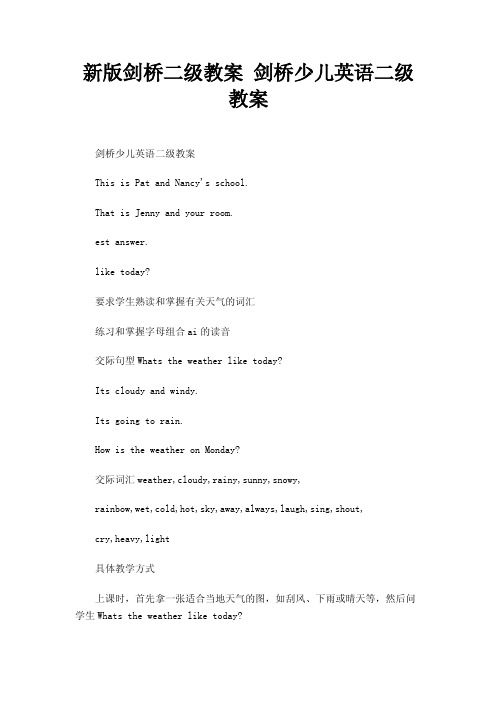
新版剑桥二级教案剑桥少儿英语二级教案剑桥少儿英语二级教案This is Pat and Nancy's school.That is Jenny and your room.est answer.like today?要求学生熟读和掌握有关天气的词汇练习和掌握字母组合ai的读音交际句型Whats the weather like today?Its cloudy and windy.Its going to rain.How is the weather on Monday?交际词汇weather,cloudy,rainy,sunny,snowy,rainbow,wet,cold,hot,sky,away,always,laugh,sing,shout,cry,heavy,light具体教学方式上课时,首先拿一张适合当地天气的图,如刮风、下雨或晴天等,然后问学生Whats the weather like today?Whats the weather like today?边说边指着外面的天气,然后再指着自己手里的晴天图说Its unny.Its sunny.Now answer my question all together.Whats the weather like today?教师讲的时候要注意用手势引发学生回答问题。
学生熟悉几遍以后,教师让学生看另外一张图并对学生说Look,its windy.说话的同时做出刮风的姿势。
然后教师将图片贴在黑板上,并在旁边写上上海,在问学生,Whats the weather like in Shanghai?教师边说边启发大家用刚才学过的巨性,Its winday.用这样的方法还可以把其他的单词一一介绍出来。
然后看第二部分。
第一部分。
Oh,we have nice pictures here.Look at the firstpart.There is aboy playing on the sand near the sea,right?Whats the weather like here?问完之后,教师期待着学生回答Its unny.教师应用快慢结合的问句来问学生。
[VIP专享]剑桥国际英语教程二(unit3-1)电子教案
![[VIP专享]剑桥国际英语教程二(unit3-1)电子教案](https://img.taocdn.com/s3/m/33e7c0063c1ec5da51e2703b.png)
课 时 计 划第 周星期 第 节 年 月 日课 题Unit 3 Time for a change!(1)教学用时 4 节教 学目 标Grammar: Evaluations and comparisons with adjectives.Speaking: Describing positive and negative features; making comparisons; talking about lifestyle changes; expressing wishes.难点评价和比较型句型的使用与区别重点描述事物的正面和反面的特征,能做比较。
英文许愿的表达方法。
教材分析教具PPT 课件教 学 过 程教学用时WORD POWERLearning objective: learn positive and negative adjectives to describe houses and apartments.Have Ss discuss their ideal home in pairs. Tell them to think about location, size, view, facilities, and features. Option : Divide Ss into three groups and 25 minsassign each group a column of vocabulary words. Ss look up the assigned words in a dictionary. Then Ss re-group and explainthe meanings.AnswersBright P inconvenient NComfortable P modern PConvenient P noisy NCramped N Private PDangerous N quiet PDark N safe PDingy N shabby NExpensive N small NHuge P spacious P15mins PERSPECTIVESLearning objectives:Listen to opinionsabout houses and apartments; see evaluations and comparisons in context.Ask Ss “ Do you prefer houses or apartments? Why?”Ss discuss the questionin pairs.Divide Ss into two groups: houses and apartments. One group writes down three disadvantages of apartments; the otherdoes the same for houses. After three minutes, have the groups exchange papersand add to the list. Go around the classand monitor Ss’ comparisons and evaluations. Don’t correct their languageyet.Ss look at the statements to see whichones they also listed. Explain the meaningof any new words.Play the audio program. Ss listen andread silently.40mins GRAMMAR FOCUSLearning objective:practice ways to evaluate and compare using adjectives and nouns.Explain the difference between evaluations and comparisons: both are judgments, but a comparison evaluates one thing against another.Have Ss circle the examples of enough and too in exercise 2. Ask : If the adjective before or after enough/too? (answer: before enough, after too )1.Enough goes after the adjective (big +enough)The apartment isn’t big enough.Enough goes before the noun (enough + closet)Houses don’t have enough closets.2.Too always goes before the adjective(too + small)Apartments are too small for pets.Point out the new structures and haveSs find examples in Exercise 2. For achallenge, have Ss determine the rules.Then write this on the board.1.As + adjective +asHouses are as convenient as apartments.Houses aren’t as safe as apartment.2.as many + count noun + asApartments have as many expenses ashouses.Apartments don’t have as many rooms ashouses3.as much + noncount noun + asHouses don’t have as much privacy asapartments.Play the audio program.教学过程教学用时板书设计布置作业Page 17 练习A和B 教学后记教研组长签名。
《剑桥国际少儿英语》第二册教材结构分析及课时安排
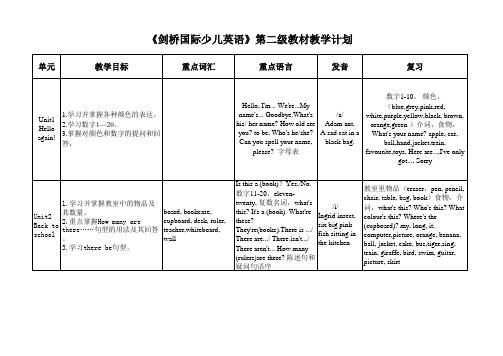
his, hers, theirs
Unit7 At the farm
1.学习农场各种动物的名称。 2.倒装句“so do I ”和否定
句的用法。 3.掌握“喜欢”、“非常喜欢 ”、“不喜欢”等英语的表达
his/ her name? How old are Adam ant,
you? to be, Who's he/she? A sad cat in a
Can you spell your name, black bag.
please? 字母表
数字1-10, 颜色, (blue,grey,pink,red, white,purple,yellow,black, brown, orange,green )介词,食物, What's your name? apple, car, ball,hand,jacket,train, favourite,toys, Here are...,I've only
atch,sunglasses, gold, 用have got的疑问句和回
mask,
答
/dj/
食物,介词,形容词,衣服,面 部和身体,房子,活动,动物, 城镇,have got,疑问句,现在 进行时表示现在正在进行的动 作,favorite,can/can't, So
do I.
Unit10 Our
时的拼写,例如:
hitting,sleeping
/th/
食物,介词,玩具,形容词,衣 服,面部和身体,房子,家庭,活 动, have got,疑问句,现在进 行时表示现在进行的动作,over
剑桥国际少儿英语二级单元教案
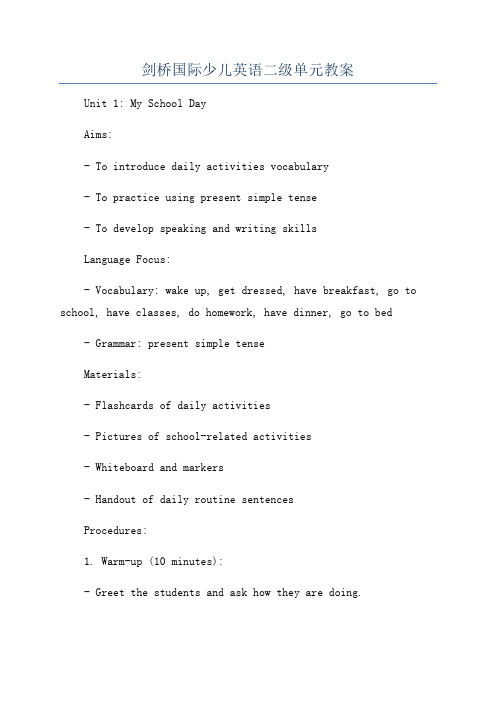
剑桥国际少儿英语二级单元教案Unit 1: My School DayAims:- To introduce daily activities vocabulary- To practice using present simple tense- To develop speaking and writing skillsLanguage Focus:- Vocabulary: wake up, get dressed, have breakfast, go to school, have classes, do homework, have dinner, go to bed - Grammar: present simple tenseMaterials:- Flashcards of daily activities- Pictures of school-related activities- Whiteboard and markers- Handout of daily routine sentencesProcedures:1. Warm-up (10 minutes):- Greet the students and ask how they are doing.- Play a quick game of Simon Says using actions related to the daily activities vocabulary (e.g. Simon says "wake up," Simon says "get dressed," etc.)2. Presentation of Vocabulary (15 minutes):- Show flashcards of the daily activities vocabulary and elicit the words from the students.- Drill the vocabulary pronunciation and have the students repeat after you.- Use the flashcards to create simple sentences and ask students to match the sentences with the corresponding pictures.3. Practice of Vocabulary (20 minutes):- Divide the class into pairs or small groups and give each group a set of pictures of school-related activities.- In turns, students should describe a picture to their partner/group using the daily activities vocabulary.- The partner/group should guess the activity being described.4. Introduction of Present Simple Tense (10 minutes):- Write examples of daily routine sentences on the whiteboard using the present simple tense (e.g. I wake up at 7:00 am, I go to school at 8:00 am, etc.).- Explain that we use the present simple to talk about routine actions that happen regularly.- Drill the sentences and have the students practice saying them out loud.5. Controlled Practice of Present Simple Tense (25 minutes):- Hand out the daily routine sentences worksheet to each student.- Monitor the students' progress and provide assistance as needed.6. Production Activity (15 minutes):- Divide the class into small groups and ask them to create a dialogue about their daily routines using the vocabulary and present simple tense.- Encourage the use of questions and answers in their dialogues.- Choose a few groups to perform their dialogues in front of the class.7. Wrap-up (5 minutes):- Review the vocabulary and present simple tense by asking students questions about their daily routines.- Thank the students for their participation and summarize the key points covered in the lesson.Note: This lesson plan is designed for a 60-minute class. It can be modified to suit different class durations and teaching styles.。
剑桥二级标准教案2

剑桥二级标准教案09.10.14Unit1 I’ve got many new friendsTeaching Aims :1.会用英语做简单的自我介绍2.更深的理解like 的用法3.会用句型I have got (会用单三人称及复数人称替换)Main Contents :1. like + ①to do/②doing2. I've go t…/He's got .../She's got...新知识教授流程Greeting: Good morning. Glad to meet you.(My name is ... I am your new teacher .)New term is coming .I hope we have a good beginning. And I believe you can become better and better. All of us have a good time. (如果是新接的班,可以加入自己的自我介绍,也可让每个孩子做一个简单的自我介绍)Warm up: Never give up ! 永不言弃 !(可以用引导的方式,让孩子慢慢地猜出这句话的意思。
)Review:Like 的用法:(用TPR 教学)I like going shopping. (作出购物的动作)I like to sing. (做出唱歌的动作)可以用 "I do you say " 操练New Knowledge :1. Pt 1Today we have got some new friends. Here is their self-introduction. Open your book and turn to page 1 .Look at Part 1 .There are six children. I want someone to pretend them. Who wants to try?(找人扮演这些角色,读,并且翻译)然后让学生自己做自己的口头自我介绍。
剑桥国际英语教程2册Unit 3

Exercise
2. Beth wishes her class were more interesting./ She wishes her class weren’t so boring. 3. My parents/ They wish they could afford a new car. 4. Dan/ He wishes he could fit into his old jeans. 5. I wish I could remember my PIN number. 6. Laura/ She wishes she had some free time.
Comparisons
Grammar focus Evaluations
adj.+ enough 【 enough修饰形容词,放 在形容词之后】 E.g. big+ enough
too+ adj. 【 too作为adv.修饰形容词 时,放在形容词之前】 E.g. too+ small
Houses aren’t as convenient as apartments. Apartments have just as many rooms as houses. Apartments don’t have as much privacy as houses.
Evaluations
As many+ count n.+ as 【和…一样多的n.】 E.g. as many rooms as houses【和房子一样多 的房间】 As much+ noncount n.+ as 【和…一样多的n.】 E.g. as much privacy as apartments【和公寓一 样多的隐私】
Book2Unit3School第1课时
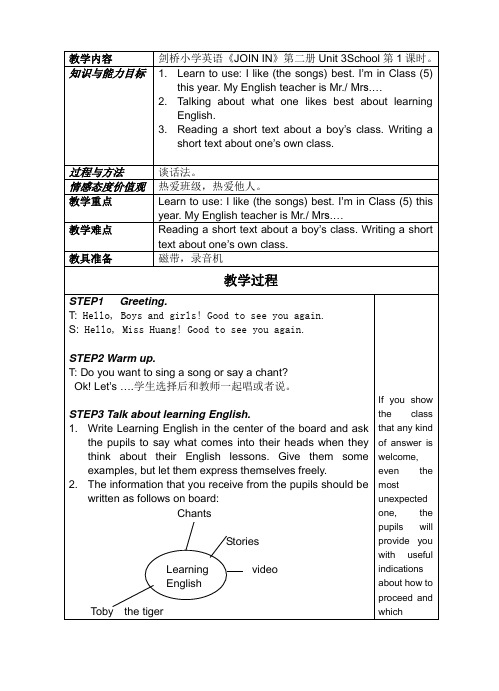
There are 12 children in his class.
His teacher’s name is Mrs. Brown.
He likes the video best.
3.Focus the pupils’attention on the first sentence,I’m Carlos, and ask them how they could change the sentence to make it true for themselves. Repeat the question for each sentence in the text so that the pupils will be able to write the same information with reference to themselves. Then ask the pupils to write the information on a sheet of paper and you should copy their texts onto a card with a photo or a drawing ofthemselves. Thesecards should be displayed in a place where they will be seen by a lot of people(inthe corridor, for example). Almost all the pupils will do their best when they know that their work is going to be displayed in public.
剑桥国际少儿英语Kids'box2 Unit3 play time-lesson1
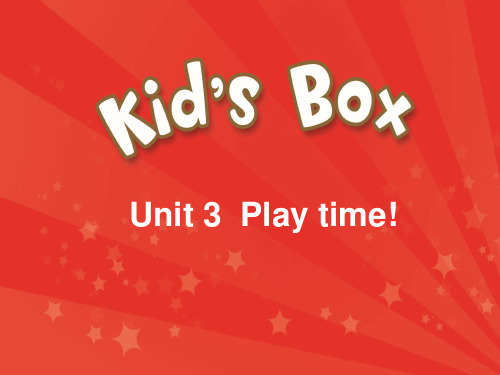
New words and vocabulary
computer game
[kəmˈpju:tə ɡeim]
lorry
lorries['lɒrɪz]
英[ˈlɒri]美[ˈlɔ:ri] 卡车; 货车
truck
n. 卡车;交易;机械呆板的人
kite
How many cameras are there? There are 18 cameras.
How many toys are there? There are 19 toys.
How many watches are there? There are 20 watches.
How many lorries are there? There are 20 lorries.
kites
[kaɪt] n 风筝; 鸢(猛禽); 空头支票;骗子
camera
[ˈkæmərə]n.照相机; 摄影机
watch
英[wɒtʃ] 美[wɑ:tʃ] n.表; 值夜,值班
camera
照相机
lorry robot
货车 机器人
computer game 电脑游戏 kite 风筝
watch 手表
Unit 3 Play time!
words reviewing
27/4
board [bɔːd]
cupboard ['kʌbəd]
碗柜;食橱
blackboard whiteboard
27/4
bookcase
['bʊkkeɪs]
ruler 'ruːlə]
teacher
['tiːtʃə]
desk
剑桥国际英语教程第二级

剑桥国际英语教程第二级The Cambridge English Second Edition curriculum is a comprehensive and well-structured program designed to help learners of all ages and proficiency levels improve their English language skills. This internationally recognized course has been meticulously developed by a team of experienced language experts to provide a robust and engaging learning experience.One of the key strengths of the Cambridge English Second Edition is its focus on practical and real-world communication. The course materials are tailored to reflect the language used in everyday situations, enabling students to develop the necessary skills to effectively express themselves in a variety of contexts. Whether it's ordering food, engaging in casual conversations, or participating in formal business meetings, the curriculum equips learners with the linguistic tools they need to navigate these scenarios with confidence.Another notable aspect of the Cambridge English Second Edition is its emphasis on integrating the four core language skills: reading, writing, listening, and speaking. Each unit of the course seamlesslyblends these elements, ensuring that students receive a well-rounded education that prepares them for authentic language use. The reading and listening activities expose learners to a diverse range of texts and audio materials, from news articles and academic papers to podcasts and video clips, allowing them to develop their comprehension abilities.The writing component of the course is particularly robust, guiding students through the process of crafting various types of written documents, such as emails, reports, and essays. Learners are provided with clear instructions, model texts, and opportunities for practice, enabling them to hone their written communication skills and develop a strong grasp of grammar, vocabulary, and organizational structure.The speaking component of the Cambridge English Second Edition is equally impressive, with a focus on developing fluency, pronunciation, and the ability to engage in natural conversations. Students participate in a range of interactive activities, from role-playing and group discussions to individual presentations, which help them gain confidence and improve their overall verbal communication abilities.One of the distinctive features of the Cambridge English Second Edition is its emphasis on vocabulary development. The courseintegrates a systematic approach to building and reinforcing vocabulary, with a focus on high-frequency words and phrases that are essential for effective communication. Learners are exposed to new vocabulary in context, and they are provided with ample opportunities to practice and apply their knowledge through a variety of engaging exercises.In addition to the core language skills, the Cambridge English Second Edition also places a strong emphasis on developing critical thinking and problem-solving abilities. The course materials incorporate activities that challenge learners to analyze information, think critically, and apply their knowledge to real-world scenarios. This approach not only enhances the learners' language proficiency but also helps them develop the cognitive skills necessary for academic and professional success.The Cambridge English Second Edition curriculum is further distinguished by its commitment to cultural awareness and sensitivity. The course materials incorporate a diverse range of perspectives and cultural references, encouraging students to develop a deeper understanding and appreciation for the diversity of the English-speaking world. This cross-cultural approach helps learners navigate the nuances of language use and fosters a more inclusive and globally-minded mindset.One of the standout features of the Cambridge English Second Edition is its adaptability to different learning styles and preferences. The course offers a range of resources and delivery methods, including textbooks, digital materials, and interactive online platforms, allowing instructors to tailor the learning experience to the needs and preferences of their students. This flexibility ensures that the curriculum can be effectively implemented in a variety of educational settings, from traditional classrooms to online and blended learning environments.The Cambridge English Second Edition also places a strong emphasis on assessment and feedback, providing learners with regular opportunities to evaluate their progress and receive constructive guidance. The course incorporates a range of assessment tools, including formative and summative assessments, as well as self-evaluation exercises, enabling students to track their development and identify areas for improvement.Furthermore, the Cambridge English Second Edition curriculum is supported by a comprehensive suite of teacher resources, including detailed lesson plans, teaching materials, and professional development opportunities. This support system ensures that instructors are equipped with the necessary tools and guidance to effectively deliver the course content and maximize student learning outcomes.In conclusion, the Cambridge English Second Edition is a meticulously designed and highly effective language learning program that is well-suited for learners of all ages and proficiency levels. Its focus on practical communication, integrated language skills, systematic vocabulary development, and cultural awareness, combined with its adaptability and robust assessment system, make it a standout choice for those seeking to enhance their English language proficiency. As an internationally recognized and respected curriculum, the Cambridge English Second Edition is a testament to the power of well-crafted and research-based language education.。
初中英语教案unit3book2
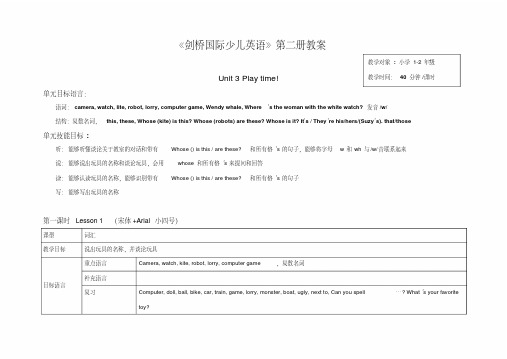
this? Where are the watches? (next to the robots)
播放录音:
What ’s Suzy looking at? (kites) 3. 说: Let ’s do activity 2. Listen, point and repeat. 播放
说出新单词 触摸新单词的书写形式 On a kite. Suzy, Mr Star, Alex, Simon, Meera, Stella
说出表示玩具的单词
跟读新单词 触摸教师说出的单词
活动设计意图 复习玩具名词
听说新单词
得分。保持队形,继续游戏。
3. 将单词卡翻过来,使有字的一面冲外,贴在黑板上。 指着单词问: What’sthis? 让学生凭记忆说出单词, 说对
的在卡片下方拼写出单词。
4. 撤掉单词卡片,黑板上留下的是玩具思维导图,玩具 名称都是文字形式。说: Now I say a toy, and you touch
说出数字
复习数字
说出名词( a camera, a watch 等)
复习表示玩具的单词
学生说出单词后,教师将单词写在黑板上,注意写成
a
(watch) 的形式。
3. 问:How many (watches, etc.) are there? 请一个学生 到前面来,从玩具箱中摸出一个纸团,展示给大家看,并
播放录音:
answer the questions. 再次播放录音, 学生听录音找答案。
CD1, 27 磁带 1, A
和全班学生一起核对答案。 2. 展示第 14 页的教学挂图, 进一步问问题, 检查听力理
解情况。如: What are these? Who ’s this? What color ’s
剑桥国际少儿英语KB2 Unit3-1

Practice sentences
This is a watch.
These are watches.
Practice Presentation
This is a robot.
These are robots.
Presentation
This is a kite.
These are kites.
Production
Homework Homework
1.听读CD,每天10-15分钟。 2.完成活动用书Part6.
3.预习歌曲。
Good bye!
Presentation
computer computer game
Presentation Practice
computer game Can you play computer game? Do you like playing computer games?
Practice
This is a
Practice Practice
I say sentence, you say number.
Practice
This is …… These are …...
Presentation Production
It’s Suzy’s.
It’s Simon’s.
It’s Stella’s.
Presentation
computer game .
computer games These are .
Presentation Presentation
kite
Practice
What’s 阿狸 doing?
阿狸 is flying a kite.
剑桥国际英语教程-2-Unit-3-Time-for-a-Changeppt课件
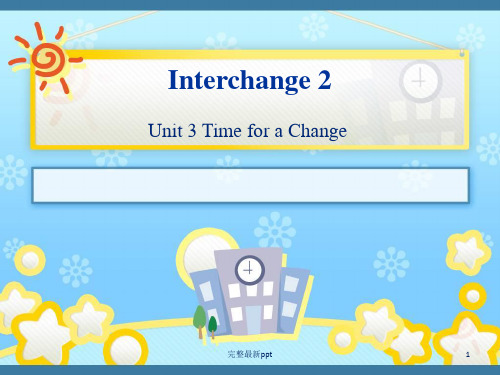
完整最新ppt
24
9. Grammar Focus wish
• Exercise A • 2. Beth wishes her class were more interesting. • 3. My parents wish they could afford a new car. • 4. He wishes he could fit into his old jeans. • 5. I wish I could remember my PIN number. • 6. laura wishes she had some free time.
parents.
完整最新ppt
20
8 Coversation
• Ture or False? • 1. Terry hates living at home. • 2. TErry's parents are always asking him to be home
before midnight. • 3. Terry thinks his life is difficult. • 4. Terry is going to move out of his parents' house
• Substitution practice & Exercise A
完整最新ppt
14
3. Grammar Focus Evaluations and Comparisons
• Comparisions with adjectives and nouns. • 1. as + adj. + as • 2. as many + count noun + as • 3. as much + noncount noun + as
Unit3MycoloursLesson1(教案)剑桥国际少儿英语第二版一年级上册
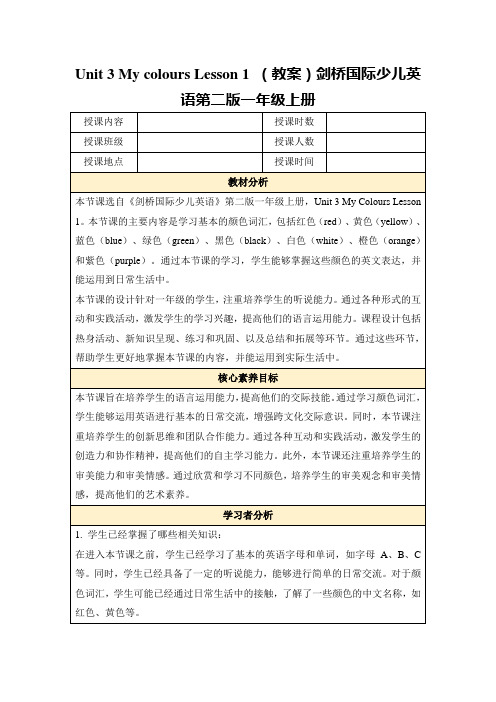
题型:给出一个颜色,要求学生用该颜色词汇造句。
答案:red(红色)- The apple is red.
16.颜色应用题
题型:给出一个场景,要求学生选择正确的颜色词汇。
答案:green(绿色)
17.颜色搭配题
题型:给出一个颜色和一个物体,要求学生选择正确的颜色词汇。
答案:blue(蓝色)
学习者分析
1.学生已经掌握了哪些相关知识:
在进入本节课之前,学生已经学习了基本的英语字母和单词,如字母A、B、C等。同时,学生已经具备了一定的听说能力,能够进行简单的日常交流。对于颜色词汇,学生可能已经通过日常生活中的接触,了解了一些颜色的中文名称,如红色、黄色等。
2.学生的学习兴趣、能力和学习风格:
7.作业布置:通过布置相关的作业,让学生在课后巩固所学知识。例如,教师可以布置一道作业:“用所学颜色词汇描述一下你的房间。”让学生在完成作业的过程中,进一步巩固和运用所学颜色词汇。
教学过程设计
1.导入新课(5分钟)
目标:引起学生对颜色词汇的兴趣,激发其探索欲望。
过程:
开场提问:“你们知道颜色是什么吗?它与我们的生活有什么关系?”
答案:yellow(黄色)
12.颜色应用题
题型:给出一个场景,要求学生选择正确的颜色词汇。
答案:red(红色)
13.颜色拓展题
题型:给出一个颜色,要求学生选择与其相邻的颜色。
答案:red(红色)- orange(橙色)
14.颜色延伸题
题型:给出一个颜色,要求学生选择与其相关的艺术领域。
答案:blue(蓝色)- music(音乐)
展示一些关于颜色的图片或视频片段,让学生初步感受颜色的魅力或特点。
剑桥少儿英语二级教案
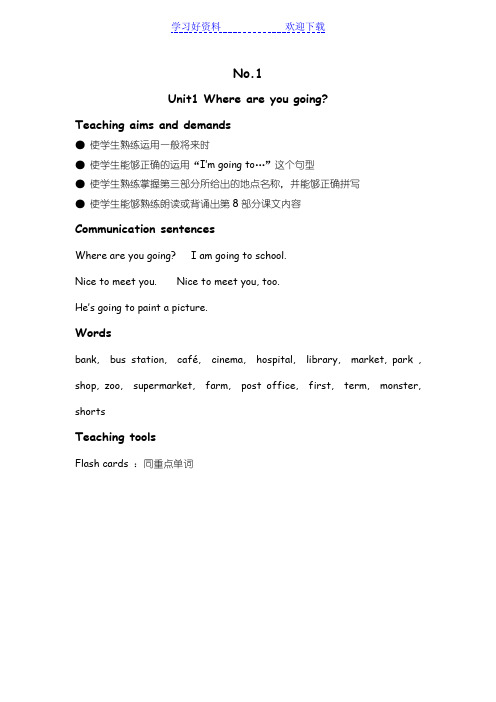
No.1Unit1 Where are you going?Teaching aims and demands●使学生熟练运用一般将来时●使学生能够正确的运用“I’m going to…”这个句型●使学生熟练掌握第三部分所给出的地点名称,并能够正确拼写●使学生能够熟练朗读或背诵出第8部分课文内容Communication sentencesWhere are you going? I am going to school.Nice to meet you. Nice to meet you, too.He’s going to paint a picture.Wordsbank, bus station, café, cinema, hospital, library, market, park , shop, zoo, supermarket, farm, post office, first, term, monster, shortsTeaching toolsFlash cards :同重点单词Teaching Procedures新课1H1.Chant it. (5min) Warm up Where are you going? We are going to school.Where is he going? He is going to school.Where is she going? She is going to school. ▼Where are they going? They are going to school.School, school.We are all going to school.2. Learn the words:(10min)Presentation 老师用英语描述一个地点,让学生根据第三部分的单词猜。
例如:We can buy a lot of fruits and vegetables here. Part 3这时学生就可以猜出老师所说的地点是Market.由此,可以▼引出本单元的重点单词:Bank , Bus station ,Cafe…Activity: 冰山一角Practice▼3.Let’s say. (20min)Presentation老师将卡片发给班里的同学,然后说:I like animals,I am going to the zoo.同时,老师走到zoo的单词卡片前, ▼再次重复一次该句型.这是老师可以再次描述:I am hungry.I am going to the supermarket to buy some bread.描述的同时可以加上夸张的表演。
- 1、下载文档前请自行甄别文档内容的完整性,平台不提供额外的编辑、内容补充、找答案等附加服务。
- 2、"仅部分预览"的文档,不可在线预览部分如存在完整性等问题,可反馈申请退款(可完整预览的文档不适用该条件!)。
- 3、如文档侵犯您的权益,请联系客服反馈,我们会尽快为您处理(人工客服工作时间:9:00-18:30)。
Learning objective:practice ways to evaluate and compare using adjectives and nouns.
Explain the difference between evaluations and comparisons: both are judgments, but a comparison evaluates one thing against another.
课时计划
第周星期第节年月日
课题
Unit 3 Time for a change!(1)
教学用时
4节
教学
目标
Grammar: Evaluations and comparisons with adjectives.
Speaking: Describingpositiveand negative features; making comparisons; talking about lifestyle changes; expressing wishes.
Huge P spacious P
PERSPECTIVES
Learning objectives:Listen to opinions about houses and apartments; see evaluations and comparisons in context.
Ask Ss“Do you prefer houses or apartments?Why?”Ss discuss the question in pairs.
Have Ss circle the examples of enough and too in exercise 2.Ask : If the adjective before or after enough/too? (answer: beforeenough, aftertoo)
1.Enough goesafter the adjective(big + enough)
教材分析
难点
评价和比较型句型的使用与区别
重点
描述事物的正面和反面的特征,能做比较。英文许愿的表达方法。
教具
PPT课件
教学过程
教学用时
WORD POWER
Learning objective:learn positive and negative adjectives to describe houses and apartments.
15mins
40mins
教学过程
教学用时
板书设计
布置作业
Page 17练习A和B
教学后记
教研组长签名
Have Ss discuss their ideal home in pairs.Tell them to think about location, size, view, facilities, and features.
Option: Divide Ss into three groups andassign each group a column of vocabulary words. Ss look up the assigned words in a dictionary.Then Ss re-group and explain the meanings.
Apartments are too small for pets.
Point out the new structures and have Ss find examples in Exercise 2. For a challenge, have Ss determine the rules.Then write this on the board.
Apartments don’t have as many rooms as houses
3.as much + noncount noun + as
Housesdon’t have as much privacy as apartments.
Play the audioHale Waihona Puke program.25 mins
Divide Ss into two groups: houses and apartments.One group writes down three disadvantages of apartments; the other does the same for houses.After three minutes, havethe groups exchange papers and add to the list.Go around the class and monitor Ss’comparisons and evaluations.Don’t correct their language yet.
1.As + adjective +as
Houses are as convenient as apartments.
Houses aren’t as safe as apartment.
2.as many + count noun + as
Apartmentshave as many expenses as houses.
Answers
BrightP inconvenient N
Comfortable P modern P
Convenient P noisy N
Cramped N Private P
Dangerous N quiet P
Dark N safe P
Dingy N shabby N
Expensive N small N
Ss look at the statements to see which ones they also listed.Explain the meaning of any new words.
Play the audio program. Ss listen and read silently.
The apartment isn’t big enough.
Enough goesbefore the noun(enough + closet)
Houses don’t have enough closets.
2.Too always goesbefore the adjective(too + small)
